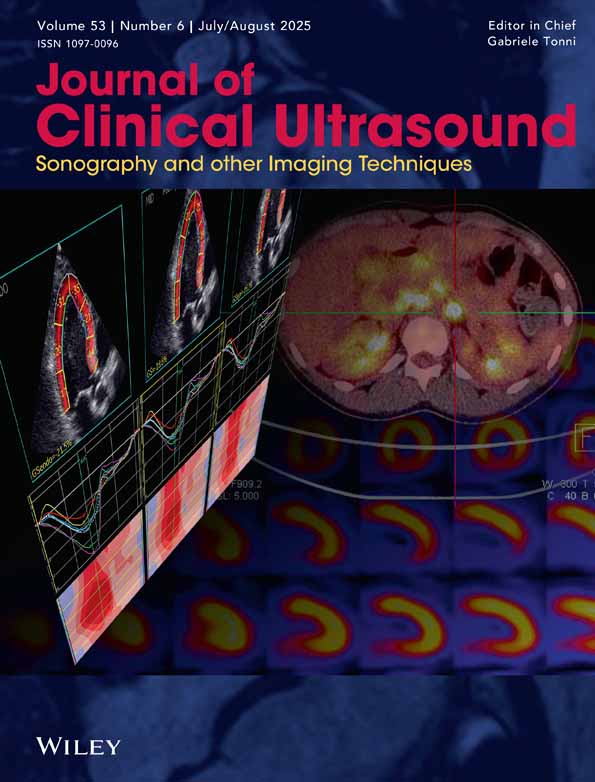The use of β-Thromboglobulin to detect platelet damage by therapeutic ultrasound in vivo
Corresponding Author
Alun R. Williams phD
Department of Medical Biophysics, University of Manchester Medical School, Manchester
ICI Central Toxicology Laboratory, Cheshire
Medical Products Development Department, The Radiochemical Centre, Amersham, Buckinghamshire, England
The Department of Medical Biophysics, University of Manchester Medical School, Stopford Building, Oxford Road, Manchester, EnglandSearch for more papers by this authorBernard V. Chater phD
Department of Medical Biophysics, University of Manchester Medical School, Manchester
ICI Central Toxicology Laboratory, Cheshire
Medical Products Development Department, The Radiochemical Centre, Amersham, Buckinghamshire, England
Search for more papers by this authorKenneth A. Allen BSc
Department of Medical Biophysics, University of Manchester Medical School, Manchester
ICI Central Toxicology Laboratory, Cheshire
Medical Products Development Department, The Radiochemical Centre, Amersham, Buckinghamshire, England
Search for more papers by this authorJoel H. Sanderson MB, ChB
Department of Medical Biophysics, University of Manchester Medical School, Manchester
ICI Central Toxicology Laboratory, Cheshire
Medical Products Development Department, The Radiochemical Centre, Amersham, Buckinghamshire, England
Search for more papers by this authorCorresponding Author
Alun R. Williams phD
Department of Medical Biophysics, University of Manchester Medical School, Manchester
ICI Central Toxicology Laboratory, Cheshire
Medical Products Development Department, The Radiochemical Centre, Amersham, Buckinghamshire, England
The Department of Medical Biophysics, University of Manchester Medical School, Stopford Building, Oxford Road, Manchester, EnglandSearch for more papers by this authorBernard V. Chater phD
Department of Medical Biophysics, University of Manchester Medical School, Manchester
ICI Central Toxicology Laboratory, Cheshire
Medical Products Development Department, The Radiochemical Centre, Amersham, Buckinghamshire, England
Search for more papers by this authorKenneth A. Allen BSc
Department of Medical Biophysics, University of Manchester Medical School, Manchester
ICI Central Toxicology Laboratory, Cheshire
Medical Products Development Department, The Radiochemical Centre, Amersham, Buckinghamshire, England
Search for more papers by this authorJoel H. Sanderson MB, ChB
Department of Medical Biophysics, University of Manchester Medical School, Manchester
ICI Central Toxicology Laboratory, Cheshire
Medical Products Development Department, The Radiochemical Centre, Amersham, Buckinghamshire, England
Search for more papers by this authorAbstract
Three sequential blood samples were drawn from arms of adult human volunteers by means of a cannula technique, and the plasma levels of β-thromboglobulin (β-TG, an index of platelet damage) were measured. Ultrasound (0.75 MHz, continuous wave; spatially averaged intensity 0.34 to 0.5 W/cm–2) was applied to the blood vessels while the second sample of each series was being taken. No elevation of β-TG was detected, indicating that under these conditions ultrasonic irradiation had not damaged an appreciable number of platelets. There was, however, an indication of decreased platelet sensitivity following insonation; and it is postulated that this may be the result of either increased production or secretion of the potent endothelial platelet inhibitor, prostacyclin, or both.
References
- 1 Chater BV, Williams AR: Platelet aggregation induced in in vitro by therapeutic ultrasound. Thrombosis and Haemostasis 38: 640, 1977.
- 2 Williams AR, Chater BV, Allen KA, et al: The release of β-thromboglobulin from human platelets irradiated in vitro with therapeutic ultrasound. Br J Haematol 40: 133, 1980.
- 3 Williams AR, O'Brien WD, Jr, Coller BS: Exposure to ultrasound decreases the recalcification time of platelet rich plasma. Ultrasound Med Biol 2: 113, 1976.
- 4 Zarod AP, Williams AR: Platelet aggregation in vivo by therapeutic ultrasound. Lancet 1: 1266, 1977.
- 5 Didisheim P, Kazmier FJ, Fuster V: Platelet inhibition in the management of thrombosis. Thrombosis Diathesis et Haemorrhagica (suppl) 32: 21, 1974.
- 6 Sevitt S: Pathology and pathogenesis of deep vein thrombosis, in L Poller (ed): Recent Advances in Thrombosis, vol 1. London, Churchill Livingstone, 1973 p 17.
- 7 Paterson JC: The pathology of venous thrombosis, in S Sherry, KM Brinkhouse, E Genton, et al (eds): Thrombosis. Washington DC, National Academy of Sciences, 1969 p 321.
- 8 Mustard JF, Packham MA: Role of platelets and thrombosis in atherosclerosis, in KM Brinkhouse (ed): The Platelet. Baltimore, Williams & Wilkins Co, 1974 p 215.
- 9 Kobayashi I, Mashimo N, Herther KK, et al: Mechanism of collagen-induced thrombocytopenia and hemoglobinemia in rats. Thrombosis Diathesis et Haemorrhagica (suppl) 60: 407, 1974.
- 10 Jørgensen L, Rowsell HC, Hovig T, et al: Adenosine diphosphate induced platelet aggregation and myocardial infarction in swine. Lab Invest 17: 616, 1967.
- 11 Honour AJ, Mitchell JRA: Platelet clumping in injured vessels. Br J Exp Pathol 45: 75, 1964.
- 12 Moore S, Pepper DS, Cash JD: The isolation and characterisation of a platelet specific protein β-globulin (B-thromboglobulin) and the detection of anti-urokinase and anti-plasmin released from thrombin-aggregated washed human platelets. Biochemica Biophysica Acta 379: 360, 1975.
- 13 Moore S, Pepper DS: Identification and characterisation of a platelet-specific release product: β-thromboglobulin, in JL Gordon (ed): Platelets in Biology and Pathology. Amsterdam, Elsevier-North Holland Biomedical Press, 1976, p 293.
- 14 Pepper DS, Ludlam CA: β-Thromboglobulin (β-TG): A new approach to the diagnosis of thrombosis. Paper presented at the “Platelets and Thrombosis” Symposium, Milan, May 1976.
- 15 Ludlam CA, Cash JD: Studies on the liberation of β-thromboglobulin from human platelets in vitro. Br J Haematol 33: 239, 1976.
- 16 Oberst H, Reichmann P: Methods of measurement used by the Federal Institute of Physical Technology for the evaluation and certification of medical ultrasonic instruments. Physikalisol Bundesonstalt 2: S35, 1953.
- 17 Carstensen EL, Schwan HP: Absorption of sound arising from the presence of intact cells in blood. J Acoust Soc Am 31: 185, 1959.
- 18 Lunan KD, Wen AC, Barfod ET, Pratt DE, and Edmonds PD: Personal Communication, 1978.
- 19 Holme S, Holmsen H: ADP-Induced refractory state of platelets in vitro, I: Methodological studies on aggregation in platelet rich plasma. Scand J Haematol 15: 96, 1975.
- 20 Moncada F, Higgs EA, Vane JR: Human arterial and venous tissues generate prostacyclin (prostaglandin X) a potent inhibitor of platelet aggregation. Lancet 1: 18, 1977.




